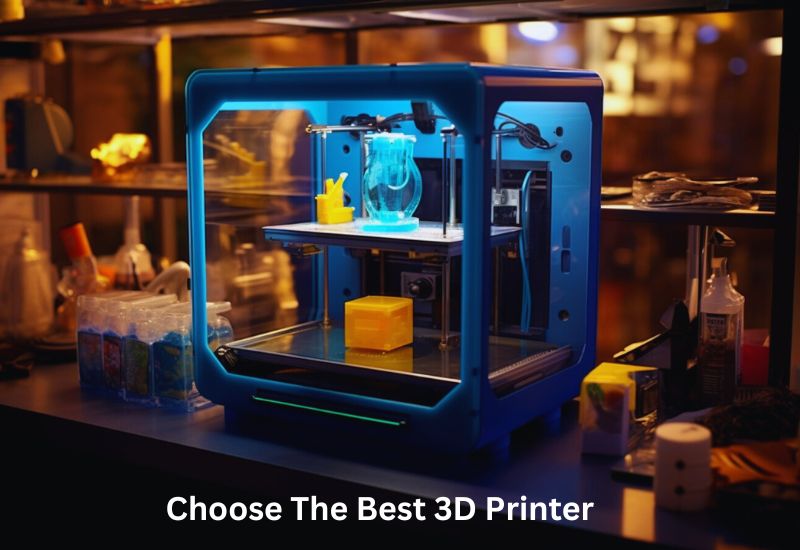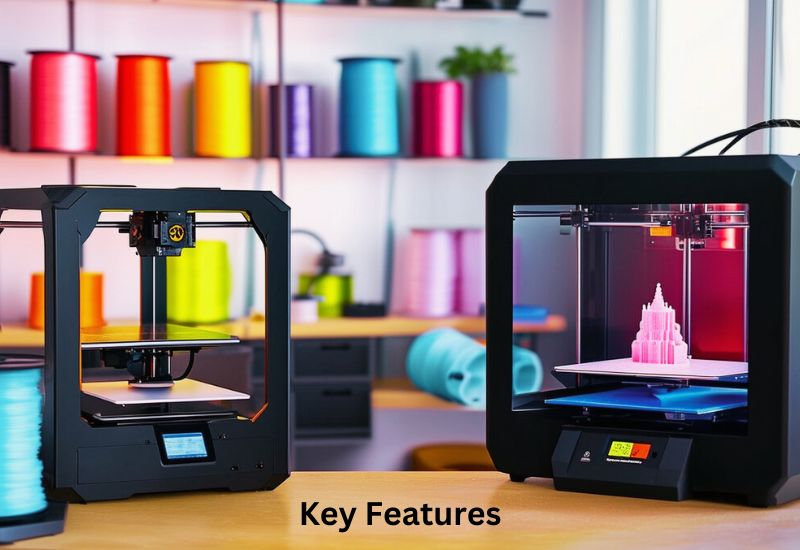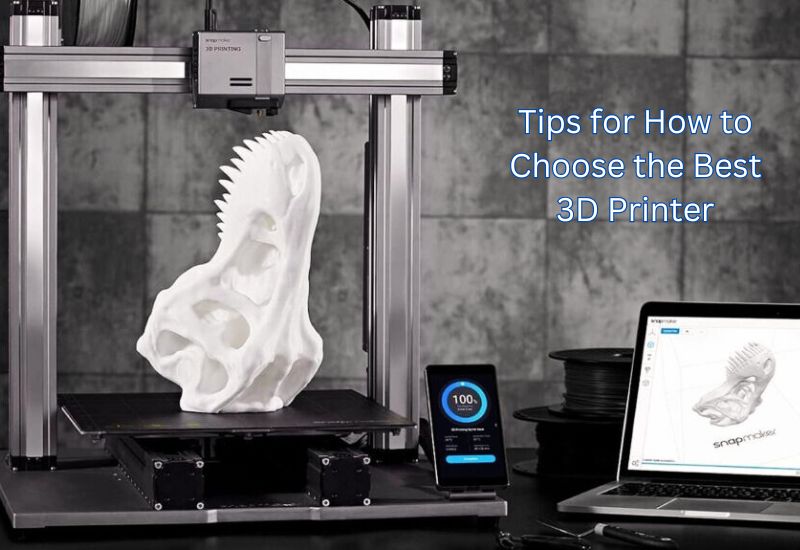How to Choose the Best 3D Printer for Small Business Success
In this article, we will learn the best way how to choose the best 3D printer for small business. According to AM Research, the 3D Printing Technologies Market reported an impressive amount of $3.45 billion in Q2 2025, up from $3.18 billion in the previous quarter, representing an 8.4% year-over-year increase.
This projection indicates significant demand and potential for 3D printing, so it is not a bad idea to consider it for your business at this time. As a longtime expert in the field of 3D printing, I can help you decide the most appropriate printer for your small business. Check out the guide to make the right choice!
Read Relevant Topic
Bambu Lab P1S: Print Advanced Filaments Flawlessly
Creality Sermoon D3 3D Printer Review

Before buying, you must know how to choose the best 3D Printer: 3 tips are below.
What Products Will You Be Making?
Start by defining your focus. Are you working on prototypes, custom products, or small-batch productions? Each requires a unique approach. If you’re wondering how to choose the best 3D printer, consider your needs carefully. Prototypes demand accuracy and a wide range of materials, while jewelry requires a high level of detail and resolution. For small quantities of tech accessories, consistency and speed are essential. Also, factor in how well your printer handles Supports from 3D Printing, especially when working with complex shapes or overhangs.
Matching Printer Features to Scale
Startups need low-cost, easy-to-use printers, while established companies require features like dual extrusion, a higher build height, and faster prints. When considering how to choose the best 3D printer for your business, it’s important to focus on features that match your current needs while also ensuring the printer can expand to meet your future requirements. This approach helps achieve the quality your business expects as it grows.
Exploring the Types of 3D Printers for Small Businesses
Small businesses have a variety of 3D printer options. Here are a few popular choices and how they cater to different requirements.
Filament-Based (FDM) Printers
Among all kinds of 3D printers, 3D FDM (Fused Deposition Modeling) printers are a great choice when learning how to choose the best 3D printer. They easily assemble large, complex parts by melting thermoplastics using layer deposition, making them ideal for various applications.
Pros for Small Businesses:
- Affordability: Budget-friendly FDM printers are available in starter and professional models.
- Ease of Use: Even beginners can operate them because they have pre-configured settings or simple slicing software.
- Flexibility: Suitable for prototypes and general-purpose products, they work with materials such as PLA and ABS.
Cons for Small Businesses:
- Detail Limitations: Fine details can be difficult to print with FDM printers, and layer lines can be visible.
- Surface Finish: For a smooth and polished look, extra post-processing, such as sanding or coating, is required.
- Durability Issues: Certain designs may not be structurally precise for intricate or thin parts.
A FDM printer can create simple items, such as prototypes, and larger structures, such as household wares. Due to their low cost and ease of entry, they are ideal starter machines for new businesses.
Resin-Based (SLA) Printers
Stereolithography (SLA) printers use liquid resin and focused light to produce highly precise objects. They are an excellent option for those wondering how to choose the best 3D printer for crafting intricate designs and highly detailed parts.
Materials They Support:
The SLA printer uses special resins specifically designed for healthcare and product design. If you’re wondering how to choose the best 3D printer, consider the availability of resins in flexible, rigid, and biocompatible forms, which are ideal for medical applications.
Best Applications for SLA Printers:
- Miniatures and Figurines: Their ability to highlight fine details makes them the favorites of artists and tabletop game creators.
- Prototypes: Sleek surfaces and high-dimensional accuracy bring your designs closer to production-quality results.
- Custom Products: SLA printers are perfect for intricate customizations, from jewelry molds to dental models.
Benefits:
- Exceptional Detail: SLA can handle the most complex geometries with superior resolution and accuracy.
- Smooth Surface Finish: Prints often come out nearly perfect, eliminating the need for labor-intensive post-processing.
Drawbacks:
- Cost of Materials: Resins are more expensive than FDM filaments.
- Limited Build Volume: Most SLA printers are designed for smaller objects, which limits scalability.
The quality of SLA printers makes them an excellent choice for artisans and technical industries that require precision and finish.
Dual-Extrusion and Advanced Hybrid Options
Dual-extrusion printers are a compelling option for artists seeking to elevate their creativity. When exploring how to choose the best 3D printer, considering dual-extrusion capabilities can be a game-changer. These printers enable simultaneous printing with two filaments, making your production process more efficient.
Unique Benefits for Small Businesses:
- Multi-Material Printing: While one extruder handles primary materials, the other utilizes dissolvable support for intricate or overhanging designs.
- Enhanced Aesthetics: Print in multiple colors or mixed materials for innovative textures and designs.
Creative Applications:
- Functional Prototypes: Create durable parts with reinforced infill and softer exteriors, such as grips or handles.
- Art and Design: Add dynamic effects with contrasting colors or mixed-texture layers, ideal for custom branding.
Considerations:
- Higher Costs: These printers might exceed a startup’s budget but pay off in versatility and innovation potential.
- Learning Curve: Configuring settings for dual extrusion can be trickier than single-material machines.
A hybrid printer incorporating dual extrusion and offering greater material compatibility is also becoming popular. If you’re wondering how to choose the best 3D printer, investing in a hybrid model would be a wise decision, especially if you plan to experiment with your creations.
Understanding the pros and cons how to choose the best 3d printer of FDM, SLA, and dual-extrusion printers can help you choose the right printer for your business. These printers offer advantages suitable for different industries and allow for more creative ideas.

Key Features to Look How to Choose the Best 3D Printer
Build Volume and Size
A large printer is necessary for large-scale production to shorten the assembly time, while a small printer is suitable for small industries.
Print Resolution and Precision
Low-layer heights, like 50 microns, are better for fine details in jewelry or medical applications. Higher resolutions, on the other hand, work better for functional prototypes.
Material Compatibility
For various businesses, from basic to complex, you can find a printer that works with materials like PLA, ABS, and resins.
Speed and Production Capabilities
To meet deadlines, efficient printers must balance quality with speed. Batch production and dual extruders increase efficiency.
User-Friendliness and Software Features
Printers with user-friendly software, automated slicing, and wireless connections ensure efficient operations and a short adjustment period.
How to Choose the Best 3D Printer: Maintenance and After-Sale Support
Easy-to-use printers are economical and ideal for various needs. When deciding on a model, knowing How to Choose the Best 3D Printer is crucial to ensure you get the right features for your requirements. Support is constantly available, which speeds up the resolution of problems, and the operations are well-coordinated without delays.
By correlating these functions, the 3D printer should match your current and future business needs.
Unique Factors for Small Business Owners
Air Quality and Ventilation
Certain kinds of 3D printers, such as ABS and resin printers, emit fumes or particles that can be hazardous if used in enclosed spaces. When learning how to choose the best 3D printer, it’s important to consider safety features like HEPA or carbon filters, especially for ABS and resin printers. Alternatively, you can use the printer outside. Adding enclosures and air cleaners can also make the work environment safer.
Scalability for Business Growth
When deciding how to choose the best 3D printer, look for one with built-in modular upgrades, larger build volumes, or multi-material capabilities. These features ensure the printer can grow with your business. Consequently, you won’t need to replace your printer if you require more intricate designs or increased production workloads.
Cost vs. Value
A budget printer may sound appealing, but the cost of ownership would eat into your profits. Materials, repairs, and electricity can quickly add up. In the long run, you will get more value from a reliable, good-quality printer than you will from an initial investment. When selecting a printer, look for features like automation and support. To make the best decision, consider how to choose the best 3D printer by focusing on durability, features, and after-sales service to ensure you get the most value over time.

Unique Tips Not Covered by Most Resources
Leveraging 3D Printing for Marketing and Branding
Using 3D printing, you can easily create branded items that promote your business, such as miniature replicas of products or customized keychains. For example, Coca-Cola’s 3D-printed miniature models caught people’s attention because they enhanced a personal touch or premium feeling suitable for handmade or high-end goods. Packaging is also a part of the experience. When considering how to choose the best 3D printer, it’s important to look for one that suits your specific business needs, whether you’re creating small items or larger promotional products.
Community and Networking Benefits
A 3D printer owner’s ability to communicate and coordinate resources with several cooperating spaces, such as maker spaces, schools, etc., can do wonders and generate new grants for them. If you’re looking to get involved in such collaborations, knowing how to choose the best 3D printer is key. The right 3D printer can make a significant difference in the success of your projects and the effectiveness of partnerships with these spaces.
How to Setup 3D Printer – Beginner’s Guide
Mass Production with 3D Printing – Industrial Usage
Comparing Popular Models for How to Choose the Best 3D Printer for Small Business Success
Finding the right 3D printer depends on your business goals. Here’s a quick guide to top choices across different needs:
Budget-Friendly for Startups
- Creality Ender 3 V3 SE ($219) is great for beginners. It offers auto bed leveling and reliable quality at 250mm/s.
- Bambu Lab A1 Mini ($199) is compact, quiet, and capable of fast multi-color printing. It is ideal for small creative projects.
- Elegoo Neptune 4 Pro ($219): Fast (500mm/s) and easy to use with broad material compatibility.
High-Precision for Detailed Designs
- Prusa MK4S ($1,099): Delivers fine details ideal for prototypes or intricate designs.
- Elegoo Mars 5 Ultra ($269): A 9K resin printer for precise miniatures or custom models.
- Anycubic Photon Mono 2 ($149): Affordable resin printer offering crisp 4K details.
Large-Batch Production
- BigRep ONE: Industry-grade with a 1 cubic meter build volume for large parts or bulk items.
- Flashforge Adventurer 5M Pro ($299): Stable and speedy (300mm/s) for batch jobs and print farms.
- Creality Ender 3 V3 KE ($299): High-speed (500mm/s) and versatile for producing multiple prints efficiently.
Select based on your production scale and business needs to succeed with 3D printing.

Final Tips for How to Choose the Best 3D Printer
Test Before You Buy
If you’re wondering how to choose the best 3D printer for your organization, it’s a great idea to visit local shops, maker fairs, or expos where 3D printers are typically showcased. This allows you to see how the printer works, identify its features, and ask questions to the specialists. If your small business needs printing speed, print quality, and ease of operation, you can check them out instantly by operating the printer. Additionally, this measure helps you choose a 3D printer that feels right for you while meeting your production needs.
Building a Long-Term Strategy for Your Printer
When deciding how to choose the best 3D printer for your business, it’s important to remember that 3D printers are not one-time purchases but rather an ongoing part of your business infrastructure. A printer’s availability of materials is also crucial for ease of use, as different printers use different types of filament. To prevent production from being impacted by a lack of materials, you must consider your order levels and your suppliers’ capabilities. Invest in printers that come with a reliable customer support system that can provide patches and software. Consider electricity costs and software update fees as part of your long-term planning when choose the best 3D printer.
Keep Learning and Improving
Your business must keep up with the rapid development of 3D printing to stay competitive. To get started, it’s important to know how to choose the best 3D printer for your needs. Join industry forums, read credible blogs, and attend conferences to learn new information and updated practices. You can improve your production by changing your materials, software, and printing techniques. You get more value from your 3D printer if you spend more time and effort learning. The more effort you put into learning, the better returns you’ll earn.
Wrapping Up
Choosing an appropriate 3D printer can determine whether a small business succeeds or fails. Test the printers yourself to ensure extensive material supplies and maintenance while monitoring industry developments to ensure your investment is not lost. If innovation is required in your business, the right combination of preparation and learning will make all the difference. With the correct 3D printer, your business can be reshaped more intelligently and efficiently.
Frequently Asked Questions (FAQs)
What is the fundamental difference between the two main types of 3D printers: FDM and Resin (SLA)?
The choice of printer type should be your first decision, as it dictates the kind of products you can make:
| Feature | FDM (Fused Deposition Modeling) | Resin (SLA/DLP) |
| Material | Thermoplastic filaments (PLA, ABS, PETG, Nylon, etc.) | Photopolymer liquid resins (Standard, Tough, Flexible, Biocompatible) |
| Process | Melts and extrudes plastic layer by layer. | Uses UV light (laser or projector) to cure liquid resin layer by layer. |
| Best For | Prototypes, functional parts, larger structures, and general-purpose items. | Highly detailed models, miniatures, jewelry molds, and precision parts. |
| Pros | More affordable, easy to use, wide material selection, lower running costs. | Exceptional detail, smooth surface finish, high dimensional accuracy. |
| Cons | Visible layer lines, requires post-processing (sanding) for smoothness. | Smaller build volume, resins are more expensive, requires messy post-curing/cleaning. |
How do I determine the right build volume and print resolution for my needs?
Build Volume (Size): This is the maximum physical size of an object the printer can create (measured across the X, Y, and Z axes).
- If you plan to print small components or jewelry, a compact resin printer is sufficient.
- If you are printing large prototypes, cosplay props, or batch-producing household items, you need a larger FDM build volume to minimize assembly time and maximize efficiency. Do not buy a printer that is “too big” unless necessary, as they are typically more expensive.
Print Resolution (Detail): This is primarily determined by the layer height (the vertical thickness of each layer, often measured in microns).
Functional parts and rapid prototypes prioritize speed and durability, so a thicker layer height and the standard 0.4 mm nozzle are typically sufficient.
Fine detail (e.g., jewelry, dental models) requires very low layer heights (e.g., 50 microns or less) and a smaller nozzle size (e.g., 0.2 mm).
Why is material compatibility and a heated print bed so important?
Material Compatibility: Different materials have different properties (strength, flexibility, heat resistance). Ensure your printer can handle the materials your projects require. For example, printing flexible filaments like TPU requires a direct drive extruder, and printing high-temperature materials like Nylon or Polycarbonate requires a hot end that can reach temperatures above 260°C.
Heated Bed: A heated print bed is vital for printing materials like ABS or PETG. These materials tend to shrink as they cool, causing the corners of the print to lift or detach from the plate—a defect known as warping. Heating the build plate helps maintain an even temperature, ensuring the first layer adheres properly.
What is ‘Infill’ and ‘Layer Height’, and how do these settings affect my final printed object?
These terms relate to the internal structure and surface quality of your print:
- Infill: The internal geometry or structure of a 3D-printed object (e.g., honeycomb, grid, or triangular pattern). Instead of printing a solid block, the infill percentage determines how much of the interior is filled with material (usually from 0% hollow to 100% solid).
- Effect: A higher infill percentage increases the strength and durability of the part but consumes more material and time. For most functional parts, 20% to 50% infill is a good balance.
- Layer Height: The thickness of each successive layer of material.
- Effect: A thinner layer height (e.g., 0.1mm) increases resolution and produces a smoother surface finish, but also significantly increases the total print time. A thicker layer height (e.g., 0.3mm) is faster but results in more visible layer lines.
Why do some 3D printers require an enclosure, and how does this relate to air quality?
An enclosure is a closed chamber surrounding the printer, serving two main purposes:
- Temperature Stabilization: For materials sensitive to temperature fluctuations, such as ABS, an enclosure maintains a stable, warmer environment, which is necessary to prevent warping and improve layer adhesion.
- Safety and Air Quality: Certain filaments (like ABS) and liquid resins emit ultrafine particles and volatile organic compounds (VOCs). Printing in an enclosed space with proper ventilation or a HEPA/Carbon filter system is crucial for safety, especially when the printer is operated in an office, classroom, or small business environment without dedicated industrial ventilation.
